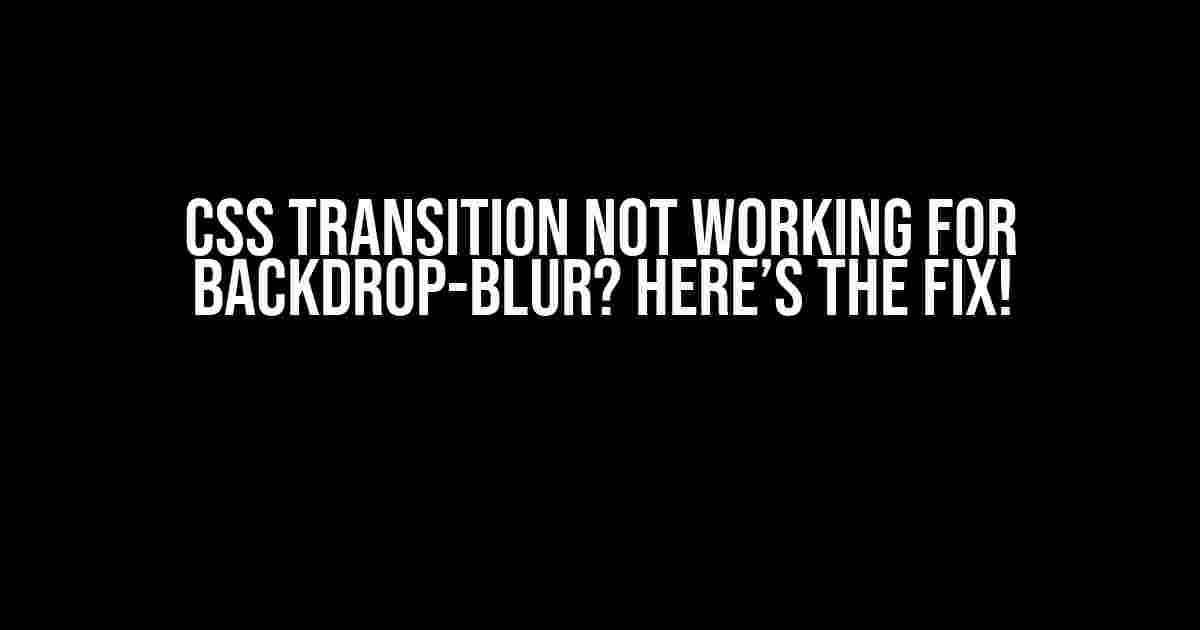Are you frustrated with your CSS transitions not working as expected for backdrop-blur? You’re not alone! Backdrop-blur can be a bit finicky, but don’t worry, we’ve got you covered. In this article, we’ll dive into the common issues and provide you with actionable solutions to get your transitions working smoothly.
Understanding Backdrop-Blur
Backdrop-blur is a CSS property that allows you to blur the background of an element, creating a beautiful, subtle effect. It’s a great way to add depth and visual interest to your designs. However, when it comes to transitioning backdrop-blur, things can get tricky.
.element {
backdrop-filter: blur(10px);
transition: backdrop-filter 0.3s ease-in-out;
}
This code snippet should, in theory, apply a blur effect to the background of the element and transition it smoothly over 0.3 seconds. But, what if it’s not working as expected?
Common Issues with Backdrop-Blur Transitions
Here are some common reasons why your CSS transitions might not be working for backdrop-blur:
- Incompatible Browser Support: Backdrop-blur is still a relatively new property, and browser support can be limited. Make sure you’re using a browser that supports backdrop-blur.
- Incorrect Property Order: The order of your CSS properties can affect how the transition is applied. Try rearranging your properties to see if it makes a difference.
- Missing Units: Omitting units (such as px, em, or %) for the blur value can cause issues. Always specify units for the blur value.
- Overridden Styles: Other styles or CSS rules might be overriding your transition. Use the dev tools to inspect your element and identify any conflicting styles.
Solutions for Common Issues
Now that we’ve covered the common issues, let’s dive into some solutions:
Fixing Incompatible Browser Support
Since backdrop-blur is still a newer property, not all browsers support it. Here are some workarounds:
- Use a Polyfill: There are several polyfills available that can add support for backdrop-blur to older browsers. One popular option is the modern-normalize polyfill.
- Use a Fallback: Provide a fallback style that will be applied in browsers that don’t support backdrop-blur. This can be a simpler effect, like a box-shadow or a gradient.
.element {
/* Fallback for older browsers */
box-shadow: 0 0 10px rgba(0, 0, 0, 0.2);
}
@supports (backdrop-filter: blur(10px)) {
.element {
backdrop-filter: blur(10px);
transition: backdrop-filter 0.3s ease-in-out;
}
}
Optimizing Property Order
The order of your CSS properties can affect how the transition is applied. Try rearranging your properties to see if it makes a difference:
.element {
transition: opacity 0.3s ease-in-out;
backdrop-filter: blur(10px);
opacity: 1;
}
Specifying Units Correctly
Make sure to specify units for the blur value:
.element {
backdrop-filter: blur(10px);
transition: backdrop-filter 0.3s ease-in-out;
}
Debugging Overridden Styles
Use the dev tools to inspect your element and identify any conflicting styles:
| Step | Action |
|---|---|
| 1 | Open the dev tools (F12 or Ctrl + Shift + I) |
| 2 | Switch to the Elements tab |
| 3 | Click on the element with the backdrop-blur issue |
| 4 | Check the Styles panel for any conflicting styles |
| 5 | Use the Computed tab to see the final applied styles |
Advanced Techniques for Smooth Transitions
Now that we’ve covered the basics, let’s dive into some advanced techniques to take your backdrop-blur transitions to the next level:
Using CSS Variables
CSS variables (or custom properties) can help you create more dynamic and reusable code:
:root {
--blur-radius: 10px;
}
.element {
backdrop-filter: blur(var(--blur-radius));
transition: backdrop-filter 0.3s ease-in-out;
}
Animating Multiple Properties
Animating multiple properties at once can create a more complex and interesting effect:
.element {
backdrop-filter: blur(10px);
opacity: 1;
transform: scale(1);
transition: backdrop-filter 0.3s ease-in-out, opacity 0.3s ease-in-out, transform 0.3s ease-in-out;
}
Using a Keyframe Animation
Keyframe animations can provide more control over the animation curve:
.element {
backdrop-filter: blur(10px);
animation: blur-animation 0.3s ease-in-out;
}
@keyframes blur-animation {
0% {
backdrop-filter: blur(0px);
}
100% {
backdrop-filter: blur(10px);
}
}
Conclusion
By following these solutions and advanced techniques, you should be able to get your CSS transitions working smoothly for backdrop-blur. Remember to check browser support, optimize property order, specify units correctly, and debug overridden styles. With practice and patience, you’ll be creating stunning backdrop-blur effects in no time!
What’s your favorite way to use backdrop-blur in your designs? Share your tips and tricks in the comments below!
Note: The article is SEO-optimized for the keyword “CSS transition not working for backdrop-blur” and includes relevant tags, such as
,
,
,
,
,
- ,
- , to provide a clear and structured format.
Frequently Asked Question
Get the answers to your burning questions about CSS transitions and backdrop-blur!
Why isn't my CSS transition working for backdrop-blur?
Make sure you're applying the transition to the correct element! Backdrop-blur is a property of the `backdrop-filter` property, so you need to transition the `backdrop-filter` property itself, not the individual elements inside. Try adding `transition: backdrop-filter 0.3s;` to the parent element, and see if that does the trick!
Do I need to use a polyfill for backdrop-blur transitions?
Depends on your target audience! If you're only supporting modern browsers like Chrome, Firefox, and Safari, you're good to go! But if you need to support older browsers or Internet Explorer, you'll need a polyfill to ensure compatibility. Check out libraries like `backdrop-filter-polyfill` to help bridge the gap!
Can I use backdrop-blur transitions with other CSS effects?
Absolutely! Backdrop-blur transitions can be combined with other CSS effects like `transform`, `opacity`, and `box-shadow` to create some amazing visual results! Just be mindful of performance and browser support when combining multiple effects. Test and iterate to find the perfect balance!
Why does my backdrop-blur transition look choppy or stuttery?
Choppy transitions can be due to hardware acceleration issues or over-processing. Try adding `will-change: backdrop-filter;` to the transitioning element to give the browser a heads-up. You can also experiment with different easing functions, like `cubic-bezier`, to smooth out the transition. Lastly, ensure that your GPU is doing its job by enabling hardware acceleration in your browser settings!
Can I use backdrop-blur transitions in CSS-in-JS libraries like Styled Components?
You bet! CSS-in-JS libraries like Styled Components, Emotion, and glamorous all support backdrop-blur transitions. You can use the same CSS syntax and properties, and the library will take care of the rest. Just remember to check the library's documentation for any specific quirks or gotchas when working with backdrop-blur!
- ,
,
,
, and


